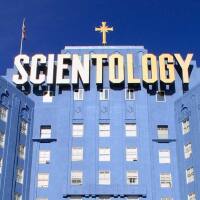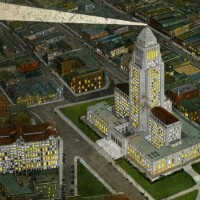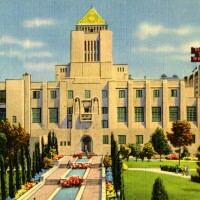Los Angeles in Buildings: The Biltmore Hotel

The Biltmore Hotel stands as one of the many answers Los Angeles has proposed, throughout nearly its entire history, to the question of what, exactly, it needs to finally become a “real city.” The list of required elements has expanded, and occasionally contracted, over time, but even putting aside all those strangely persistent Baudrillardian anxieties about whether it rates as a genuine place or some kind of postmodern accretion of simulacra, Angelenos seem never to have a definitive answer about whether Los Angeles has, quite literally, the right stuff.
By the 1920s, anyone looking across the continent to New York for a model of the real city would have believed that Los Angeles couldn't possibly enter the world class without a grand downtown hotel.
At the moment, the city's deficiencies in public transit and public space in general look like the ones to address; back in the second half of the century, it strove for real-city status primarily by building art museums, concert halls, and other high-profile cultural venues. But during and after Los Angeles' initial population boom at the end of the 19th century and the beginning of the 20th, the city needed to worry less about reality than capacity, a need that demanded the construction of hotels. After the opening of the Pico House in 1870, an extravagant hostelry by the standards of the time and place, the importance of capacity gave way to that of luxury. By the 1920s, anyone looking across the continent to New York for a model of the real city (as many did, and quite a few still do) would have believed that Los Angeles couldn't possibly enter the world class without a grand downtown hotel: not just a place for high-status visitors, but a reassuringly opulent icon for Angelenos themselves.


Unsurprisingly, as David Rieff writes in “Los Angeles: Capital of the Third World,” the job of designing the Biltmore went to a New York office, Schultze and Weaver, “a firm noted for its uncanny ability to ape the style of the great Spanish colonial architects like Churriguera while at the same time modifying them to suit the requirements of the Jazz Age.” The money, some $10 million of it, came arranged by banker Joseph Sartori, who, according to California historian Kevin Starr, “organized the six-hundred-stockholder syndicate behind the Biltmore whose leadership — Harry Chandler, Marco Hellman, Henry M. Robinson, Lee Phillips — proceeded from the same social groupings which had secured water from Owens Valley in 1913 and were about to improve the port.” Rieff describes projects of this kind as “less the work of individual entrepreneurs than the collective undertakings of the business establishment, and the amorphous Mediterraneanism of their design was an integral part of the selling of Los Angeles.”
A grand downtown hotel should, of course, stand across from a well-landscaped central park. In Los Angeles this meant the periodically torn up and reconfigured Pershing Square, which then accorded to a design by John Parkinson, the architect of several downtown buildings (including the Braly Block) who would go on to work on the likes of City Hall and Union Station. Ultimately St. Paul's Cathedral, occupant of the most promising piece of Pershing Square-adjacent real estate on Olive Street, had to go to make way for the new hotel. The Biltmore's 18-month construction began in 1921, and when it opened on Oct. 2, 1923 — as the largest hotel west of Chicago, then boasting 1,500 rooms — it did so with a lavish, much reported-on gala whose attendees numbered over 3,000.

![Pews and altar of Saint Paul's Episcopal Church, [s.d.]](https://kcet.brightspotcdn.com/dims4/default/bdec835/2147483647/strip/true/crop/2839x2249+0+0/resize/848x672!/quality/90/?url=http%3A%2F%2Fkcet-brightspot.s3.us-east-1.amazonaws.com%2Flegacy%2Fsites%2Fkl%2Ffiles%2Fthumbnails%2Fimage%2Fst_paul_interior.jpeg)
The building itself offered plenty to draw their eyes away from the festivities: marble fountains and columns, travertine walls, crystal chandeliers, cast bronze fixtures, elaborate tapestries, an indoor pool lifted straight from the luxury ocean liners of the day — and not least, with three towers rising to eleven stories over half a city block, sheer scale. But none would attract more attention, then as now, than the frescoed mural ceilings painted by the highly regarded artist Giovanni Battista Smeraldi, brought in from Italy to spend the better part of a year painting on a scaffold, Michelangelo-style, and thus (along with the staircase modeled after the one in Spain's Burgos Cathedral) anointing the still-new Southern Californian metropolis' east coast-inspired grand downtown hotel with more than a touch of old-world respectability.
The hiring of Smeraldi, previously known for painting the White House and the Vatican, aligned perfectly with the spare-no-expense vision that Biltmore chain owner John McEntee Bowman had for his Los Angeles project. With its opening, he once said, “this great city becomes more than ever a gathering place of the smart people of the world.” The “host of the coast,” as the Biltmore would soon come to be known, went on to figure into several chapters of 20th-century history: as the site of a well-known speakeasy during Prohibition, a rest and recreation facility for military personnel on leave during the Second World War, the headquarters of the 1960 Democratic National Convention where John F. Kennedy became the party's presidential nominee, and a stop on the Beatles' first American tour in 1964, when the fan-thronged streets forced them to enter through the roof by helicopter.


![Interior of the "Biltmore Bowl", a large ornate dining room in the Biltmore Hotel, [s.d.]](https://kcet.brightspotcdn.com/dims4/default/e108df5/2147483647/strip/true/crop/1920x1532+0+0/resize/848x677!/quality/90/?url=http%3A%2F%2Fkcet-brightspot.s3.us-east-1.amazonaws.com%2Flegacy%2Fsites%2Fkl%2Ffiles%2Fthumbnails%2Fimage%2Fbiltmore_bowl_0.jpeg)
In this sense the Biltmore has much in common with the Ambassador, the now-demolished hotel built a few years earlier and three miles to the west. Like the Biltmore, the Ambassador also hosted political gatherings (most notably in 1968, when it was the scene of the assassination of John F. Kennedy's younger, also presidential-hopeful brother Robert), and both also hosted Academy Award ceremonies. Eight of them happened in the 1930s and 40s in the Biltmore Bowl, an extra ballroom added especially to accommodate the Oscars. Other additions and subtractions made after the hotel's initial construction include the Biltmore Theater, a success until the redeveloped Bunker Hill stole the rest of downtown's high-cultural thunder; the relocation of its main lobby to the rear of the building in the name, of course, of easier vehicular access; as well as several renovations and restorations.
One such rehabilitative effort happened in the 1970s, by which time the Biltmore, along with most of the other institutions of Los Angeles' old downtown, struck some as just about ready for the wrecking ball. (Pershing Square, regarded as a gathering place for beggars and criminals, looked even worse.) Architect-developer Gene Summers and his business partner Phyllis Lambert stepped in, bought the building at a bargain-basement price, and set about restoring the place to health, not just by cleaning up Smeraldi's painted ceilings but introducing a modern, or at least modernized, aesthetic atop the existing one: furniture by Ludwig Mies van der Rohe (of whom Summers was once a professsional associate), multicolored lithographs by pop artist Jim Dine. Many of Summers and Lambert's design choices didn't last into the twenty-first century, but their stewardship solidified the Biltmore's reputation as a survivor.
The project of modernizing such a resolutely, even deliberately un-modern building comes with a certain irony, especially in the context of the architecturally forward-looking Los Angeles of the early twentieth century. “While Richard Neutra was designing the Lovell House,” writes Metropolis Magazine's Andrew Blum, “Schultze and Weaver were transferring Florentine Renaissance gardens to Miami Beach.” The firm specialized, as Jonathan Mogul writes in an exhibition catalog on their work, “offered an architecture of luxury, one that created environments designed to produce a sense of pleasure, privilege, and prestige.” (Their post-Biltmore Los Angeles projects included the exclusive Jonathan Club.) This sensibility reached its apotheosis not in the Biltmore but nine years later and on the other side of the country in New York's Waldorf-Astoria Hotel, still today a byword for a quaint idea of thoroughly implemented urban luxury.


“Some buildings defy criticism by their almost miraculous mixture of good and bad elements, as difficult to sort as a thousand grains of light and dark sand,” wrote architectural historian and critic Lewis Mumford in the New Yorker about the Waldorf-Astoria. “Modernism, revivalism, eclecticism, and plain gimcrackery have all had their hand in producing the Waldorf. Nothing is decisive and clear; perhaps that is the capital effect.” Hipper New Yorkers still instinctively look upon that hotel as kitsch, though kitsch of a solid, benevolent and sometimes even admirable kind, a monument to the city's faded, nearly vanished aristocracy. Had Los Angeles ever produced a viable aristocracy of its own (another requirement for real-city status?), perhaps Angelenos would feel the same way about the Biltmore, which, among its qualities with the potential for faintly ironic appreciation, still serves high tea in its old lobby, now branded the “Rendezvous Court.”
One suspects that when today's hipper Angelenos pass by the Biltmore, most of them don't even see it, and those who do regard it as little more than an interesting, possibly haunted anachronism.
But one suspects that when today's hipper Angelenos pass by the Biltmore, most of them don't even see it, and those who do regard it as little more than an interesting, possibly haunted anachronism. (Rumors persist of hauntings by ghosts of nurses, young children, and famous murder victim Elizabeth Short, better known as the “Black Dahlia” and last seen at the Biltmore, but management insists that they've rendered none of the rooms unrentable.) Some will find more appeal in the 1925 Subway Terminal Building, Schultze and Weaver's later, similarly shaped downtown project which, after half a decade of extensive renovation, reopened in 2005 as the Metro 417 lofts. Though ostensibly marketed to visitors, the Biltmore, as Kevin Starr writes, was actually “an exuberantly public performance” intended “primarily for Los Angeles itself” — but one that Angelenos now more than sold on city life, real or otherwise, haven't necessarily needed to see for themselves.


